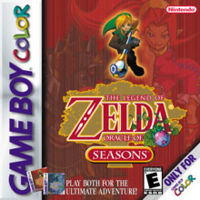The Legend of Zelda: Oracle of Seasons

| |
| The Legend of Zelda: Oracle of Season | |
| Developer | Flagship |
| Publisher | Nintendo |
| System | Game Boy Color |
| Release Date | JP February 27, 2001 US May 14, 2001 EU October 5, 2001 |
| Genre | Adventure |
| Gallery | Gallery |
| Rating | ESRB: E |
The Legend of Zelda: Oracle of Seasons is a Zelda game for the Game Boy Color. It was released at the same time as The Legend of Zelda: Oracle of Ages. which it acts as a companion to.
Development
The Oracle games started off when Flagship's head coerced Nintendo into allowing them to create six handheld Zelda games. The original idea was two would be remakes of earlier games, starting with a new version of the original The Legend of Zelda (the other would presumably be Zelda II: The Adventure of Link). However, they had problems bringing Zelda to the Game Boy Color due to the difficulties sprouting from the different screen sizes, and they also modified the map beyond recognition to make it easier for the newer generation of players.
At Shigeru Miyamoto's suggestion, the plan was converted into a "Triforce Trilogy" of connected games, which became referred to in English as Mystical Seed of Power, Wisdom and Courage. The first game would be action-oriented, the second would involve color-based puzzles, while the final game would involve the mechanic of solving puzzles at different times of day. One of the titles would still be based on The Legend of Zelda. Once they decided to connect the games through a password system, it proved to be complicated enough that it was decided that one of the games should be cancelled. Mystical Seed of Courage was cancelled, while the other two games became Oracle of Seasons and Oracle of Ages, although they still incorporated some homages to The Legend of Zelda.
Story
Link is called by the Triforce to the temple in which it is held held. After touching the Triforce, Link is transported to a forest. Soon, Link comes upon a troupe of traveling entertainers. Their dancer, Din, welcomes Link to Holodrum and dances with Link. As they dance, the sky grows dark and Onox announces that he's come for the Oracle of Seasons. A tornado takes Din away and the seasons are thrown in disarray.
Impa, who was traveling with the group, tells Link that she was trying to take Din to Hyrule. She tells Link to see the Maku Tree at Horon Village. Link finds a sword in a cave and makes his way to the Maku Tree. The Maku Tree tells Link that he must find the eight Essences of Nature as well as the Rod of Seasons in order to enter Onox's stronghold and defeat him. With that, Link begins his quest.
Gameplay
Oracle of Seasons plays much like The Legend of Zelda: Link's Awakening. It uses the same two button control system and features the same balance of exploration, puzzle-solving, and action.
The central item of Oracle of Seasons is the Rod of Seasons. Using the Rod of Seasons, the player can change the season. This is used to solve various puzzles. For example, the player might change the season to winter to freeze a pond that was blocking the way before.
Another unique feature is the connectivity the game shares with Oracle of Ages. At the end of the game, the player is given a password that allows them an alternate version of Oracle of Ages. The game is changed slightly to become a sequel to Oracle of Seasons. A password from Oracle of Ages does the same for Oracle of Seasons. Passwords can also be used to get upgraded items and to transfer rings from one game to another.
Continuity Notes
- This game takes place at a time when Ganon is already deceased, which would seem to place it at a late point in the series. The Triforce also appears to be in Hyrulean possession (although the status of the Triforce is not clearly possessed), which would match up with the endings of Zelda II: The Adventure of Link as well as A Link to the Past.
- Twinrova specifically appears and plays a vital role in the revival of Ganon. This connects with Ocarina of Time, where they were introduced as Ganondorf's surrogate mothers. It is uncertain but clearly possible that these two are the same witches. The only point of possible doubt is their apparent death during Ocarina, although then again revelations about the ending of Ocarina make it possible that they survived in the other timeline.
- Link starts both games with a Triforce mark in his hand, which is shown to be the mark of the hero. This specifically acts as a callback to Zelda II.
- These games also features new versions of various characters from both Ocarina of Time and Majora's Mask. Although this would be a recurring feature in future games, these were the first games to reuse characters without an in-game explanation.
- The ending of the linked Oracle of Ages/Seasons game could be possible foreshadowing to Link's Awakening, as Link is seen leaving on a ship while what appears to be a storm is seen in the distance. It seems to be set to lead directly into the opening scenario of Link's Awakening, although it has been most commonly cited (and originally intended) as a follow-up to A Link to the Past.
Legacy
The Oracle games marked the beginning of Flagship and Capcom's role in making Zelda games. They continued with several more contributions in the following years, some of which incorporated nods to the Oracle games, until they ended with The Minish Cap in 2004.
Sequels
The next game in the Zelda series was Four Swords, which was released with a remake of A Link to the Past.